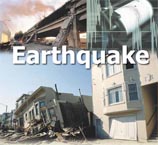Taiwan scientist claims breakthrough in earthquake early warning
 Taipei - A Taiwan scientist has made breakthrough in earthquake early warnings, allowing the public be warned 10 to 30 seconds before a major quake causes destruction, a newspaper said Monday.
Taipei - A Taiwan scientist has made breakthrough in earthquake early warnings, allowing the public be warned 10 to 30 seconds before a major quake causes destruction, a newspaper said Monday.
The breakthrough was achieved by Wu Yi-min, associate professor in the Geophysics Department of the National Taiwan University. It can give the public more time to seek safety, as currently the quickest alert Taiwan's Seismological Observation Centre can give is
30 second after a quake has struck, the China Times said.
According to Wu, after an earthquake has occurred, it sends out s- waves and p-waves. S-waves are the less destructive horizontal waves, while p-waves are devastating vertical waves.
As s-waves travel 1.73 times faster than p-waves, Wu has worked out the correlation between the p-waves and the magnitude of the quake, which means that by analysing the characteristics of p-waves, he can gauge the destructive force of the quake.
Wu tested his method at the South California earthquake monitoring network, the paper said.
The test showed that after an earthquake, four to six monitoring stations recorded features of the p-wave within seven seconds after the quake had struck. Adding the time of computer transmission, a warning could be sent out 10 seconds before a quake starts to cause damage.
The China Times said that Wu's method can prevent or cut property damage or loss of life because 10 is enough for someone to switch off a gas stove, for a bullet train to slow down or for a nuclear power plant's reactors to be shut.
Taiwan's Seismological Observation Centre can measure an earthquakes' magnitude no sooner than 18 seconds after the quake's begins. Measuring the magnitude and sending out the warning takes at least 30 seconds.
Wu plans to invent a portable earthquake early-warning gadget so that people can receive early warnings from the Seismological Observation Centre after a strong quake has struck.
According to the China Times, Wu has submitted his findings to the Geophysical Research Letters, and his research has attracted attention from many countries including Japan, South Korea and from the Pacific Tsunami Warning Centre.
Taiwan's Seismological Observation Centre said it will not adopt Wu's method until the accuracy of his earthquake early-warning can be proven, the paper said.
Taiwan sits on the circum-Pacific seismic belt and experiences hundreds of earthquakes each year, but most are mild tremors.
On September 21, 1999, an earthquake measuring 7.3 on the Richter scale struck in Taichung Country, central Taiwan, killing 2,400 people and injuring more than 10,000 people. (dpa)